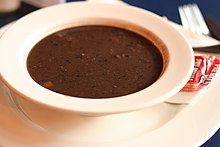Burundian cuisine

| Part of a series on the |
| Culture of Burundi |
|---|
 |
| People |
| Languages |
| Cuisine |
| Religion |
| Art |
| Music |
| Sport |


Burundi is situated in East Africa and has a territory full of mountains, savannas and agricultural fields, with forests in the surrounding rivers and waters. Agriculture is spread on 80% of the country's surface and it mainly includes coffee, tea, maize, beans and manioc. Burundi cuisine also includes beans, which are the staple of Burundi cooking, exotic fruits (mainly bananas), plantains, sweet potatoes, cassava, peas, maize and cereals, like corn and wheat.[1]
A major aspect when discussing Burundian cuisine is based on the economic conditions of the country: the Burundian people usually eat homemade food, from homemade vessels also used for drinking, carrying water and storing grain. Food security remains a major problem in Burundi.[citation needed]
Ingredients
Most of Burundi's dishes are soups that consist of a variety of foods, spices, and herbs such as:
Typical dishes

- Ugali—maize or cassava flour porridge
- Curry
- Maharagwe—bean soup
- Ibiharage—fried beans
- Beans and bananas
- Bean soup
- Matura and mahu—type of sausage
- Boko Boko harees
See also
References
- http://recipes.wikia.com/wiki/Burundian_Cuisine (licensed under the Creative Commons Attribution-Share Alike License)
- Cuisine, The Cook in African; Recipes; Cuisine, Burundian; Recipes; Cuisine, Central African; Recipes; World, Cuisines of the (2013-12-20). "Burundian Cuisine". Aussie Taste Recipes. Retrieved 2020-04-09.
- "Gastronomy in Burundi". SpainExchange Country Guide. Retrieved 2020-04-09.
- "In Burundi, What Do Farmers and Food Waste Have in Common?". World Food Program USA. Retrieved 2020-04-09.
